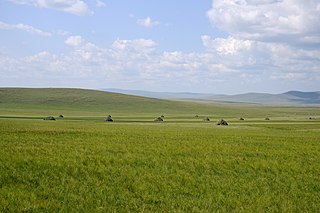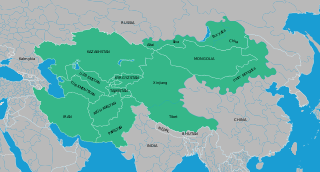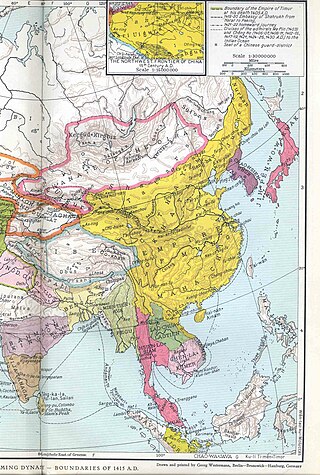Related Research Articles

The Mongols are an East Asian ethnic group native to Mongolia, China, as well as Buryatia and Kalmykia of Russia. The Mongols are the principal member of the large family of Mongolic peoples. The Oirats in Western Mongolia as well as the Buryats and Kalmyks of Russia are classified either as distinct ethno-linguistic groups or subgroups of Mongols.

Inner Mongolia, officially the Inner Mongolia Autonomous Region, is an autonomous region of the People's Republic of China. Its border includes two-thirds of the length of China's border with the country of Mongolia. Inner Mongolia also accounts for a small section of China's border with Russia. Its capital is Hohhot; other major cities include Baotou, Chifeng, Tongliao, and Ordos.

Inner Asia refers to the northern and landlocked regions spanning North, Central and East Asia. It includes parts of western and northeast China, as well as southern Siberia. The area overlaps with some definitions of "Central Asia", mostly the historical ones, but certain regions that are often included in Inner Asia, such as Manchuria, are not a part of Central Asia by any of its definitions. Inner Asia may be regarded as the western and northern "frontier" of China proper and as being bounded by East Asia proper, which consists of China proper, Japan and Korea.

Buddhism is the largest religion in Mongolia practiced by 51.7% of Mongolia's population, according to the 2020 Mongolia census. Buddhism in Mongolia derives much of its recent characteristics from Tibetan Buddhism of the Gelug and Kagyu lineages, but is distinct and presents its own unique characteristics.

Öndör Gegeen Zanabazar was the first Jebtsundamba Khutuktu and the first Bogd Gegeen or supreme spiritual authority, of the Gelugpa lineage of Tibetan Buddhism in Mongolia.

Pan-Mongolism is an irredentist idea that advocates cultural and political solidarity of Mongols. The proposed territory, called "Greater Mongolia" or "Whole Mongolia" usually includes the independent state of Mongolia, the Chinese region of Inner Mongolia, and the Russian region of Buryatia. Sometimes the autonomous republic Tuva, the Altai Republic and parts of Xinjiang, Zabaykalsky Krai, and Irkutsk Oblast are included as well. As of 2006, all areas in Greater Mongolia except Mongolia have non-Mongol majorities.

Mongolia under Qing rule was the rule of the Manchu-led Qing dynasty of China over the Mongolian Plateau, including the four Outer Mongolian aimags and the six Inner Mongolian aimags from the 17th century to the end of the dynasty. The term "Mongolia" is used here in the broader historical sense, and includes an area much larger than the modern-day state of Mongolia. By the early 1630s Ligdan Khan saw much of his power weakened due to the disunity of the Mongol tribes. He was subsequently defeated by the Later Jin dynasty and died soon afterwards. His son Ejei handed the Yuan imperial seal over to Hong Taiji in 1635, thus ending the rule of the Northern Yuan dynasty in Inner Mongolia. However, the Khalkha Mongols in Outer Mongolia continued to rule until they were overrun by the Dzungar Khanate in 1690, and they submitted to the Qing dynasty in 1691.

The Khorchin are a subgroup of the Mongols that speak the Khorchin dialect of Mongolian and predominantly live in northeastern Inner Mongolia of China.

The Northern Yuan was a dynastic regime ruled by the Mongol Borjigin clan based in the Mongolian Plateau. It existed as a rump state after the collapse of the Yuan dynasty in 1368 and lasted until its conquest by the Jurchen-led Later Jin dynasty in 1635. The Northern Yuan dynasty began with the retreat of the Yuan imperial court led by Toghon Temür to the Mongolian steppe. This period featured factional struggles and the often only nominal role of the Great Khan.

The Dzungar people are the many Mongol Oirat tribes who formed and maintained the Dzungar Khanate in the 17th and 18th centuries. Historically, they were one of the major tribes of the Four Oirat confederation. They were also known as the Eleuths or Ööled, from the Qing dynasty euphemism for the hated word "Dzungar", and as the "Kalmyks". In 2010, 15,520 people claimed "Ööled" ancestry in Mongolia. An unknown number also live in China, Russia and Kazakhstan.
Various nomadic empires, including the Xiongnu, the Xianbei state, the Rouran Khaganate (330–555), the First (552–603) and Second Turkic Khaganates (682–744) and others, ruled the area of present-day Mongolia. The Khitan people, who used a para-Mongolic language, founded an empire known as the Liao dynasty (916–1125), and ruled Mongolia and portions of North China, northern Korea, and the present-day Russian Far East.

Mongolian literature is literature written in Mongolia and/or in the Mongolian language. It was greatly influenced by and evolved from its nomadic oral storytelling traditions, and it originated in the 13th century. The "three peaks" of Mongol literature, The Secret History of the Mongols, Epic of King Gesar and Epic of Jangar, all reflect the age-long tradition of heroic epics on the Eurasian Steppe. Mongol literature has also been a reflection of the society of the given time, its level of political, economic and social development as well as leading intellectual trends.

Tibet under Yuan rule refers to the Mongol-led Yuan dynasty's rule over Tibet from 1244 to 1354. During the Yuan dynasty rule of Tibet, the region was structurally, militarily and administratively controlled by the Mongol-led Yuan dynasty of China. In the history of Tibet, Mongol rule was established after Sakya Pandita got power in Tibet from the Mongols in 1244, following the 1240 Mongol conquest of Tibet led by the Mongol general with the title doord darkhan. It is also called the Sakya dynasty after the favored Sakya school of Tibetan Buddhism.
Buddhists, predominantly from India, first actively disseminated their practices in Tibet from the 6th to the 9th centuries CE. During the Era of Fragmentation, Buddhism waned in Tibet, only to rise again in the 11th century. With the Mongol invasion of Tibet and the establishment of the Mongol Yuan dynasty (1271–1368) in China, Tibetan Buddhism spread beyond Tibet to Mongolia and China. From the 14th to the 20th centuries, Tibetan Buddhism was patronized by the Chinese Ming dynasty (1368–1644) and the Manchurian Qing dynasty (1644–1912) which ruled China.

The Dzungar genocide was the mass extermination of the Mongol Dzungar people by the Qing dynasty. The Qianlong Emperor ordered the genocide after the rebellion in 1755 by Dzungar leader Amursana against Qing rule, after the dynasty first conquered the Dzungar Khanate with Amursana's support. The genocide was perpetrated by Manchu generals of the Qing army, supported by Turkic oasis dwellers who rebelled against Dzungar rule.

Religion in Inner Mongolia is characterised by the diverse traditions of Mongolian-Tibetan Buddhism, Chinese Buddhism, the Chinese traditional religion including the traditional Chinese ancestral religion, Taoism, Confucianism and folk religious sects, and the Mongolian native religion. The region is inhabited by a majority of Han Chinese and a substantial minority of Southern Mongols, so that some religions follow ethnic lines.
Anti-Mongolianism, also called anti-Mongolian sentiment, has been prevalent throughout history, often perceiving the Mongols to be barbaric and uncivilized people with a lack of intelligence or civilized culture.
The Bolor Erike is a Mongolian chronicle written by Rashpuntsag in 1776."Information Mongolia" calls the Bolor Erikh an important moment in Mongolian historiography. This history is said to have “made a successful attempt at critical assessment of the sources and appraisal of various historical events. Moreover, Rashpuntsag substantiated in his own way imperative need for ctiticism and dispute in recording history". Rashpunstag suggested that Xiongnu were a Mongolic people. American Mongolist Dr.Christopher Atwood of Indiana University, noted that Rashpuntsag "was the first Mongolian historian to be significantly influenced by Chinese historical writing and make use Chinese historical data (1998:330).

The Yuan dynasty in Inner Asia was the domination of the Yuan dynasty in Inner Asia in the 13th and the 14th centuries. The Borjigin rulers of the Yuan came from the Mongolian steppe, and the Mongols under Kublai Khan established the Yuan dynasty (1271–1368) based in Khanbaliq. The Yuan was a Chinese dynasty that incorporated many aspects of Mongol and Inner Asian political and military institutions.

The Ming dynasty in Inner Asia was the expansion of the Ming dynasty's realm and influence in Inner Asia between the 14th and the 16th centuries. The Ming dynasty overthrew and succeeded the Mongol-led Yuan dynasty and sought to avert further incursions by a regime originating from Inner Asia. Wars were fought against the Northern Yuan, which existed as a rump state after the collapse of the Yuan dynasty in 1368, but also against other states in Inner Asia including the Oirat Confederation and Moghulistan. As a result, Ming China at the height incorporated Manchuria, much of the regions of Inner Mongolia and Qinghai, and parts of Xinjiang into its realm, and also had some degree of influence in Tibet especially during the reign of the Yongle Emperor.
References
- 1 2 3 "Mongolian literature". Britannica. Archived from the original on 18 May 2021. Retrieved 18 May 2021.
- 1 2 Woolf, D.R. (2014). A Global Encyclopedia of Historical Writing Volume 2. Taylor & Francis. p. 630. ISBN 978-1-134-81998-0.
- 1 2 Inner Asia Volume 8. White Horse Press for the Mongolia and Inner Asia Studies Unit at the University of Cambridge. 2006. p. 80.
- 1 2 3 Elverskog, Johan (2008). Our Great Qing The Mongols, Buddhism, and the State in Late Imperial China. University of Hawaii Press. p. 80. ISBN 978-0-8248-6381-4.